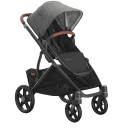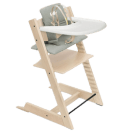
Babies are bundles of joy that bring laughter, happiness, and, yes, plenty of used diapers into our lives. As essential as diapering is to child-rearing, managing a diaper pail can sometimes become a challenging task, especially when it comes to controlling odors. But fear not! Keeping your diaper pail from turning into a stink bomb is (mostly) possible with a few tips and tricks. This guide offers practical advice to ensure your nursery remains a fresh and pleasant space for you and your baby.
Choose the Right Diaper Pail
The first step in combating diaper pail odors starts with selecting the right pail. While it’s true that no diaper pail will be 100% funk-free all of the time, some contain smells better than others. What makes one option better than another? Here’s what to look for:
Sealing Method
Some pails have a twisting mechanism that seals the bag’s mouth each time you close the lid, “locking” each individual dirty diaper into a tidy package. In our experience, diaper pails with this type of bag-sealing feature are much better at containing the stink than pails that operate like traditional trashcans, where you toss the diaper in and call it a day.
Odor Control Tech
These aren’t your granny’s diaper pails. Newer models have been upgraded with some major funk-fighting features:
- Carbon Filters: These are built into the lid or the pail’s side and effectively absorb and neutralize odors. Remember, these filters need to be replaced regularly to maintain their effectiveness.
- Scented Pads: Some pails use scented pads or air fresheners to help mask odors. While this does not eliminate the smell, it can make opening the pail a more pleasant (?) experience. Of course, your mileage may vary—some Albee parents think using scented bags and air fresheners simply creates a “poop-pourri.”
- Special Liners: Diaper pails that use proprietary liners are designed to lock in odors. These liners are usually more expensive than regular trash bags, but they often offer superior odor control thanks to their thick, multi-layered construction. Some are even biodegradable or have added features like antimicrobial protection.
- UV Light: Some diaper pails have hospital-grade UV lights built into the lid, which automatically disinfect surfaces and help eliminate stinky germs.
Material
The material of the diaper pail can also impact odor control. Metal pails are better at containing smells than plastic models because metal doesn’t absorb odors. Plastic pails might be lighter and less expensive, but they can retain odors over time, even with regular cleaning.
Ease of Use + Capacity
While not directly related to odor control, the ease of use and capacity of the diaper pail are important to consider. A pail that’s difficult to open, close, or empty might lead to delays in disposing of diapers, which can contribute to odor buildup. Similarly, a larger capacity means less frequent emptying but also means odors have more time to accumulate. Find a balance that works for your family’s needs and your willingness to manage the disposal process.
Regular Cleaning and Emptying is a Must
Ensuring your diaper pail remains a fresh part of your nursery involves a bit of elbow grease—but don’t worry, it’s simpler than it sounds. Incorporate diaper pail maintenance into your daily pick-up routine, and wipe down its surfaces with antimicrobial wipes or a vinegar and water solution.
We’d suggest doing a deeper clean once a month. Hot, soapy water is your best friend in this endeavor, but let’s not forget the secret weapons: Vinegar and baking soda. These household staples are eco-friendly and incredibly effective at neutralizing odors.
- Vinegar Solution: A natural disinfectant, vinegar cuts through residues and eliminates lingering smells. Mix one part of distilled white vinegar with three parts of water for a safe and powerful cleaning solution.
- Baking Soda Paste: A paste made from baking soda and water can work wonders for tougher spots. Baking soda’s mild abrasive nature helps scrub away dried-on messes without damaging the pail. Plus, its odor-absorbing properties get to work even as you clean.
After washing, thoroughly dry each part of your diaper pail. Moisture can be a breeding ground for mold and mildew, contributing to unwanted smells and potentially harming your nursery’s air quality. If weather permits, letting the pail and its components air-dry outside in the sun speeds up the drying process and uses the sun’s natural sanitizing properties to your advantage.
Even with regular cleanings, life happens, and sometimes, smells can sneak up on you. Keeping a small spray bottle filled with your vinegar solution nearby allows quick touch-ups between deep cleans. Spritzing the inside of the pail or wiping down the lid can be a fast fix for sudden stink.
But the easiest and most effective way to keep your diaper pail from turning into a smelly nightmare? Empty it before it’s full and prevent nasty smells from accumulating and absorbing into the pail.
Use All the Baking Soda
Baking soda is a humble pantry staple that doubles as a superhero for disinfecting your nursery. Embracing the natural power of baking soda in your diaper pail routine can transform your nursery into a fresh and hygienic space for cuddles and play.
Baking soda is more than just an ingredient for your favorite chocolate chip cookie. It’s a powerful, natural odor absorber, perfect for keeping your diaper pail smelling fresh. Its magic lies in its ability to neutralize acidic and basic odor molecules, transforming them into neutral, odorless states. Baking soda isn’t just masking odors; it’s eliminating them at the source.
Easy as a Sprinkle
Starting with a clean diaper pail, a generous sprinkle of baking soda at the bottom before you place the liner in acts as the first defense against odors. As you add diapers, the baking soda continues to work, neutralizing odors before they can start.
A Box in the Corner
Place an open box of baking soda near or inside your diaper pail for an added layer of freshness. This passive odor control method works around the clock, pulling odors from the air and keeping the nursery smelling cleaner and fresher. It’s a set-it-and-forget-it solution, and isn’t that music to any harried parent’s ears?
Monthly Refresh
To maintain its maximum odor-neutralizing power, replace the baking soda in your diaper pail and the open box nearby monthly. This small but impactful routine ensures your nursery remains a welcoming, odor-free zone. You can mark it on your calendar or tie it to another monthly task to help you remember.
Proper Diaper Disposal
How you dispose of diapers can also impact the smell of your diaper pail. Before tossing a diaper, ensure it’s tightly rolled up and secured with its tabs. Securing the diaper into a taught little package minimizes the surface area exposed to air, reducing odor escape. For particularly stinky diapers, consider using small, scented trash bags or diaper disposal bags before putting them in the pail.
Air It Out
Fresh air isn’t just revitalizing for us—it can do wonders for your diaper pail, too. Air circulation really impacts your diaper pail’s funk level. When a diaper pail is kept closed all the time, the lack of airflow can cause bacteria and odors to build up more quickly. By allowing your pail to air out regularly, you’re introducing a natural flow that helps disperse odors and reduce the growth of odor-causing bacteria. This practice can be as simple as leaving the pail open and outside (or in a well-ventilated area) while your baby is awake and you’re changing diapers less frequently.
Consider Deodorizers or Scents
Market-available deodorizers designed for diaper pails can help mask odors. Alternatively, essential oils can offer a natural solution. Add a few drops of lavender, lemon, or peppermint oil to a piece of cloth and place it at the bottom of your pail or inside the lid. These scents can help freshen the air without overwhelming it with artificial fragrances.
Line Smart
Using the right liner can also make a difference. Some parents swear by scented liners for an added layer of odor protection, while others prefer the eco-friendly route with washable cloth liners.
Scented liners are designed to provide an additional barrier against odors, embedding pleasant fragrances directly into the liner material. Here’s what to consider:
- Odor Protection: These liners often contain odor-neutralizing agents or are infused with fragrances to mask unpleasant smells. They can be a quick solution for keeping the nursery smelling fresh between cleanings.
- Variety: You’ll have plenty of scents to consider, from lavender to fresh linen. It may take trial and error to determine which scent best minimizes stinkiness.
- Compatibility: Ensure the scented liners you choose are compatible with your specific diaper pail model. A snug fit prevents leaks and maximizes odor control.
Be mindful that some babies (or you!) may be sensitive to fragrances. You may need to pick a new bag if you notice any sneezing, congestion, or discomfort.
For families prioritizing environmental sustainability, eco-friendly liners offer a responsible choice without compromising on convenience.
- Biodegradable Options: Many eco-friendly liners are biodegradable or compostable, breaking down much faster than traditional plastic liners and reducing your carbon footprint.
- Washable Cloth Liners: A reusable option that can be washed and reused, cloth liners are gentle on the planet and soft to the touch. They require more effort but significantly cut down on waste.
- Health and Safety: These liners are often made without chemicals or fragrances, making them a safer option for babies with sensitive skin or allergies.
Choosing eco-friendly liners means thinking about how to dispose of or clean them. Check if your local waste management facilities can accommodate biodegradable options. For cloth liners, establish a routine for washing and drying to maintain hygiene and readiness for use.
Keeping your diaper pail from becoming a source of unpleasant odors is all about proactive and consistent care. You can maintain a fresh and inviting nursery by choosing the right pail, cleaning regularly, and employing smart strategies to combat smells. Remember, a little effort goes a long way in ensuring your baby’s environment is as clean and healthy as possible.
Finding What’s Right for You
Albee Baby is the oldest family-owned specialty baby shop in the US, and we pride ourselves on providing our customers with the best assortment of baby products anywhere, at fair prices, always. We’re committed to being an inclusive resource for parents and hope you feel empowered to find the right baby gear for your family. Still have questions? Feel free to contact our baby gear experts at 877.692.5233 or info@albeebaby.com.
 Car Seat Sale
Car Seat Sale
 Stroller Sale
Stroller Sale
 Home Sale
Home Sale
 Feeding Sale
Feeding Sale
 Activity & Entertainment Sale
Activity & Entertainment Sale
 Bath & Potty Sale
Bath & Potty Sale






 Car Seats
>
Car Seats
>
 Strollers
>
Strollers
>
 Cribs
Cribs
 High Chairs
High Chairs
 Baby Carriers
Baby Carriers
 Travel Cribs & Playards
Travel Cribs & Playards
 Wagons
Wagons
 Home
>
Home
>
 Bath & Potty
>
Bath & Potty
>
 Diaper Bags & Backpacks
Diaper Bags & Backpacks
 Toys
>
Toys
>
 Gifts
>
Gifts
>
 Clothing
>
Clothing
>

















 Infant Car Seats
Infant Car Seats
 Convertible Car Seats
Convertible Car Seats
 All-in-One Car Seats
All-in-One Car Seats
 Booster Car Seats
>
Booster Car Seats
>
 Travel Systems
Travel Systems
 Car Seat Accessories
Car Seat Accessories
 Single Strollers
Single Strollers
 Double Strollers
Double Strollers
 Single-to-Double Strollers
Single-to-Double Strollers
 Lightweight & Compact Strollers
Lightweight & Compact Strollers
 Jogging Strollers
Jogging Strollers
 Bicycle Trailers & Child Seats
Bicycle Trailers & Child Seats
 Stroller Accessories
Stroller Accessories
 Stroller Frames
Stroller Frames



































